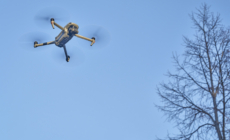-
Phillies Acquire Jesus Luzardo From NL East Rival Marlins: Reports - 7 mins ago
-
Removing Carbon From the Sky Could Be the Next Climate Gold Rush - 31 mins ago
-
California’s rush to regulate AI has a 1st Amendment problem - 38 mins ago
-
Face of Shelter Dog Spending His Fourth Christmas Alone Breaks Hearts - 42 mins ago
-
The Enigma of Bob Dylan - about 1 hour ago
-
Toddler’s Guilt Trip Works to Perfection on Grandma: ‘Caved In Too Quick’ - about 1 hour ago
-
Newsom reads the election returns and heads to red California - about 1 hour ago
-
‘SNL’ Takes on New Jersey Drones: ‘Dumb Theories’ - 2 hours ago
-
A Woman With a Rare Gene Mutation Fights to Avoid Her Mother’s Fate - 2 hours ago
-
Newsom and a fellow Democrat spar over constitutional convention on gun control - 2 hours ago
Map Shows Russian Military Planes Encircling US Ally Japan
Two Russian military aircraft on Thursday circumnavigated around Japan and entered South Korea’s air defense zone, resulting in the two allies of the United States scrambling fighter jets.
The Joint Staff Office under Japan’s defense ministry reported the movement of a pair of Tu-142 maritime reconnaissance and anti-submarine warfare aircraft, also known as “Bear F” under NATO reporting names, inside the Japanese air defense identification zone, or ADIZ.
The “Bear F” entered South Korea’s ADIZ during the encirclement flight around Japan, local media cited the country’s military as saying. In response, Japanese and South Korean fighter jets were deployed. Both Tokyo and Seoul are Washington’s security treaty allies in Asia.
An ADIZ is an area of international airspace where the tracking and identification of aircraft is required for national security purposes. On Wednesday, the North American Aerospace Defense Command detected and tracked two Russian military aircraft in the Alaska ADIZ.
The long-range flight comes as Russia is conducting two air and naval exercises in its Far East region with China. One of the exercises, China-led Northern/Interaction-2024, is underway in the Sea of Japan, which is situated west of Japan, and the Sea of Okhotsk.
The other military maneuver is the Ocean-2024, where exercise areas include the Pacific Ocean. This strategic exercise has been taking place since Tuesday and is scheduled for a week. The Chinese military has announced that its forces participated in this Russian military drill.
The “Bear F” is derived from the Tu-95 “Bear” turboprop strategic bomber, specializing in hunting submarines and patrolling vast ocean areas. It has a reported range of 7,456 miles and is equipped with specialized equipment for anti-submarine warfare and surveillance.
The Japanese military said the “Bear F” flew from the Sea of Japan to the East China Sea via the Tsushima Strait, a waterway that separates Japan to the east and South Korea to the west. The aircraft then continued southward and flew west of Japan’s Ryukyu Islands.

Japan’s defense ministry
After reaching near Japan’s island of Okinawa, the “Bear F” passed over the Miyako Strait and entered the Philippine Sea. They changed their flight routes afterward and were on a northeastward course until arriving near Hokkaido, one of the four main Japanese islands.
The “Bear F” returned to the Sea of Japan and the Russian Far East region by flying near and over the four southernmost Kuril Islands and the La Perouse Strait, also known as the Soya Strait, that separates Hokkaido to the south and Russia’s Sakhalin Island to the north.
The disputed Kunashiri, Etorofu, Shikotan and Habomai islands of the Kuril Island chain were seized by the Soviet Union at the end of World War II. Japan claimed them as its “Northern Territories,” and the issue has strained ties between the two sides for decades.
The Russian defense ministry on Friday reported that during Ocean-2024, eight anti-submarine warfare aircraft, including two pairs of “Bear F,” conducted a group search for submarines of a simulated enemy in the Sea of Japan, using radar and sonar for tracking.
Newsweek reached out to Russia’s defense ministry with a written request for comment.
Source link



















